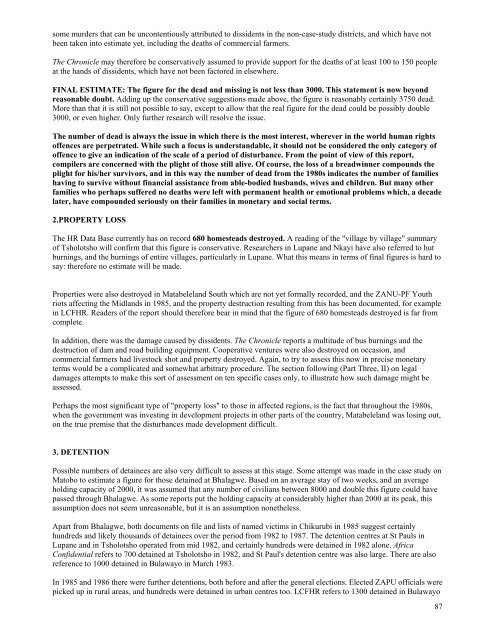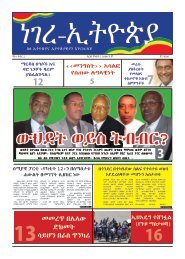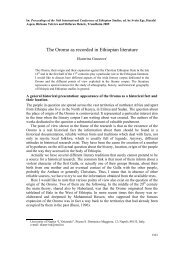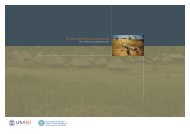MatabelelandReport
MatabelelandReport
MatabelelandReport
You also want an ePaper? Increase the reach of your titles
YUMPU automatically turns print PDFs into web optimized ePapers that Google loves.
some murders that can be uncontentiously attributed to dissidents in the non-case-study districts, and which have not<br />
been taken into estimate yet, including the deaths of commercial farmers.<br />
The Chronicle may therefore be conservatively assumed to provide support for the deaths of at least 100 to 150 people<br />
at the hands of dissidents, which have not been factored in elsewhere.<br />
FINAL ESTIMATE: The figure for the dead and missing is not less than 3000. This statement is now beyond<br />
reasonable doubt. Adding up the conservative suggestions made above, the figure is reasonably certainly 3750 dead.<br />
More than that it is still not possible to say, except to allow that the real figure for the dead could be possibly double<br />
3000, or even higher. Only further research will resolve the issue.<br />
The number of dead is always the issue in which there is the most interest, wherever in the world human rights<br />
offences are perpetrated. While such a focus is understandable, it should not be considered the only category of<br />
offence to give an indication of the scale of a period of disturbance. From the point of view of this report,<br />
compilers are concerned with the plight of those still alive. Of course, the loss of a breadwinner compounds the<br />
plight for his/her survivors, and in this way the number of dead from the 1980s indicates the number of families<br />
having to survive without financial assistance from able-bodied husbands, wives and children. But many other<br />
families who perhaps suffered no deaths were left with permanent health or emotional problems which, a decade<br />
later, have compounded seriously on their families in monetary and social terms.<br />
2.PROPERTY LOSS<br />
The HR Data Base currently has on record 680 homesteads destroyed. A reading of the "village by village" summary<br />
of Tsholotsho will confirm that this figure is conservative. Researchers in Lupane and Nkayi have also referred to hut<br />
burnings, and the burnings of entire villages, particularly in Lupane. What this means in terms of final figures is hard to<br />
say: therefore no estimate will be made.<br />
Properties were also destroyed in Matabeleland South which are not yet formally recorded, and the ZANU-PF Youth<br />
riots affecting the Midlands in 1985, and the property destruction resulting from this has been documented, for example<br />
in LCFHR. Readers of the report should therefore bear in mind that the figure of 680 homesteads destroyed is far from<br />
complete.<br />
In addition, there was the damage caused by dissidents. The Chronicle reports a multitude of bus burnings and the<br />
destruction of dam and road building equipment. Cooperative ventures were also destroyed on occasion, and<br />
commercial farmers had livestock shot and property destroyed. Again, to try to assess this now in precise monetary<br />
terms would be a complicated and somewhat arbitrary procedure. The section following (Part Three, II) on legal<br />
damages attempts to make this sort of assessment on ten specific cases only, to illustrate how such damage might be<br />
assessed.<br />
Perhaps the most significant type of "property loss" to those in affected regions, is the fact that throughout the 1980s,<br />
when the government was investing in development projects in other parts of the country, Matabeleland was losing out,<br />
on the true premise that the disturbances made development difficult.<br />
3. DETENTION<br />
Possible numbers of detainees are also very difficult to assess at this stage. Some attempt was made in the case study on<br />
Matobo to estimate a figure for those detained at Bhalagwe. Based on an average stay of two weeks, and an average<br />
holding capacity of 2000, it was assumed that any number of civilians between 8000 and double this figure could have<br />
passed through Bhalagwe. As some reports put the holding capacity at considerably higher than 2000 at its peak, this<br />
assumption does not seem unreasonable, but it is an assumption nonetheless.<br />
Apart from Bhalagwe, both documents on file and lists of named victims in Chikurubi in 1985 suggest certainly<br />
hundreds and likely thousands of detainees over the period from 1982 to 1987. The detention centres at St Pauls in<br />
Lupane and in Tsholotsho operated from mid 1982, and certainly hundreds were detained in 1982 alone. Africa<br />
Confidential refers to 700 detained at Tsholotsho in 1982, and St Paul's detention centre was also large. There are also<br />
reference to 1000 detained in Bulawayo in March 1983.<br />
In 1985 and 1986 there were further detentions, both before and after the general elections. Elected ZAPU officials were<br />
picked up in rural areas, and hundreds were detained in urban centres too. LCFHR refers to 1300 detained in Bulawayo<br />
87







